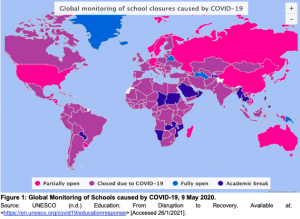By Melissa Philippou
During the past year, the coronavirus pandemic has forced governments in 188 countries to temporarily close down their educational institutions, heavily disrupting the education and learning process of more than 1.7 billion students across the globe[1]. In commemoration of the International Day of Education, it is important to identify, analyse and evaluate the short- and long-term implications of school closures to develop a deeper understanding of the limitations the pandemic has already posed on education[2].
By the end of March 2020, UNESCO estimated that 161 country-wide school closures had forced out of school over 89% of the total population of students enrolled in school or university, representing 1.54 billion students globally[3]. Figure 1 demonstrates that school closures became a reality in most countries by May 2020, with only a handful of countries maintaining school doors open. This figure fluctuated throughout the year, reaching its lowest level at the end of December with only 8.6% of total enrolled learners being affected by 11 country-wide school closures, representing approximately 150 million students worldwide[4].

However, the year 2021 started off with another round of national lockdowns and temporary school closures, further exacerbating the harm posed on education during the past year. From March onwards, government efforts to curb the spread of the deadly virus have passed through various phases, enabling at times the use of distance learning as the default learning process. Yet, with UNICEF calling for the urgent prioritization of school openings in mitigation plans in its most recent press release, the questions that need to be raised are, is distance learning effective enough? And, to what extent have school closures impacted the education of children and youth in different parts of the world?
The closure of schools across the world due to the coronavirus pandemic did not only affect students, but also the students’ families as well as teachers and the society as a whole. It has brought to light various social and economic consequences[5], namely, student debt[6], digital learning[7], food insecurity[8], and homelessness[9]. Further, it has imposed grave obstacles to the access to childcare[10], healthcare[11], housing[12], internet access, and services for people with disabilities. Most importantly though, school closures have had a greater impact on less privileged children, as consequences for this group of children include interrupted learning, reduced food availability, childcare problems and financial costs for families who could not work because of pandemic[13]. Specifically, in low income countries where only 34% of children complete school, the COVID-19 pandemic has undoubtedly exacerbated existing inequalities in education.
Short term consequences
School closures have generated multiple social and economic implications for different social groups, hitting the most marginalized and vulnerable children or young adults the hardest, along with their families. First, the interruption of the learning process during the transitional period from physical to digital learning led to the deprivation of opportunities for students to grow and develop[14]. This is particularly true for under-privileged students who oftentimes do not possess many educational opportunities and resources beyond those provided by the school[15]. In fact, it is estimated that for more than 500 million students worldwide, distance learning remains out of reach[16]. During this transitional period, maintaining connections between teachers and students has proved to be problematic or uneven, thus having serious consequences on students’ education[17]. Moreover, the learning process of several students across the world was disrupted by the unpreparedness of some parents for distance learning and homeschooling, especially for those with limited education and/or resources[18].
Second, many working parents were forced to leave their children alone at home in the absence of alternative options, which could lead to an increase of substance abuse, peer pressure, or social isolation.[19] Indeed, a sharp increase of mental health issues was recorded among students during the first months of the coronavirus pandemic. According to a survey conducted in the United States (US), the COVID-19 outbreak contributed to the rise of stress, anxiety, depressing thoughts, fear about their own health and that of their loved ones, difficulty in concentrating, disruptions to sleeping patterns and greater concerns for their academic performance. Nonetheless, the opposite has also been a recurring phenomenon. Many working parents have missed work to take care of their children, having short term economic impacts from wage loss as well as long term negative impacts on productivity[20]. In the case of health workers for example, childcare obligations indirectly put unintended yet additional strain on national health-care systems.
Third, in countries where schools provide free or discounted meals for students, the nutrition and eating habits of many students was compromised once school closures were in effect[21]. Fourth, school closures can lead to the increased exposure of children and youth to exploitation and violence[22]. For instance, in several countries, namely, Liberia, Sierra Leone and Guinea[23], school closures are closely linked to the rise of gender-based violence and sexual exploitation of girls, of early or forced marriages, of teenage pregnancies, of child soldier recruits by militia, and of child labour exploitation[24].
Long term consequences
Although the full extent of the impact of school closures during the past year might take years to be fully substantiated, adapting learning practices to the COVID-19 era has revealed a number of long term implications on the existence of and access to quality education. Perhaps the most important implication has been the accumulated burden placed on school funding[25]. As countries around the world enter a third lockdown, it is still uncertain if schools will be able to weather the fiscal uncertainty looming over them. Governments and school leadership boards have already been faced with a surge of additional costs directly related to COVID-19 response measures, such as purchasing new equipment to support distance learning (i.e. laptop, software programs and IT specialists) and implementing health safety and social distancing measures.
Furthermore, as national economies are going through recession periods, there is limited funding available to be poured into the education sector. At the same time, financial uncertainty itself can lead to the rise of school dropouts, which can drive down national and international educational standards. UNESCO underscored that this phenomenon tends to occur as a result of “protracted closures and when economic shocks place pressure on children to work and generate income for financially distressed families.”[26] Subsequently, the fall in national revenues and the increased cost pressure have caused schools to take strenuous decisions and make difficult financial cuts, including laying off members of the staff. This could negatively impact not only the economy, but most importantly, it could affect student performance and achievements.
Nonetheless, it is essential to note that school dropouts as a result of the economic impacts posed by COVID-19 have disproportionately affected adolescent girls, further entrenching gender gaps within education[27]. This is often the case for young girls and women in the Global South, where only limited social protection mechanisms are in place, given that “economic hardships caused by the crisis will have spill-over effects as families consider the financial and opportunity costs of educating their daughters.”[28] For example, in countries that have one of the lowest enrolment rates and completion rates for girls, namely, Niger, Mali and South Sudan, school closures due to epidemics or pandemics have already forced over 4 million young girls out of school. In addition, this is also true for refugee or internally displaced girls who are already at a disadvantage, being only half as likely to enrol to school as their male counterparts.
Lastly, school closures due to the COVID-19 pandemic have posed serious challenges on measuring and validation systems, notably, tests and examinations that determine student performance, admission to higher education and advancement to new education levels and institutions[29]. In numerous countries including the United Kingdom and the United States, final examinations were postponed or cancelled in 2020, considering that online examinations continuously raise concerns about fairness, in particular “when access to learning becomes variable.”[30] Such disruption to assessment results lead to uncertainty for the future, thus causing more stress for students, which could potentially trigger further disengagement from the school learning process.
Evidently, the impact of the coronavirus pandemic on education has been and continues to be severe. With approximately 90% of students being kept out of school as a result of mitigation practices to limit the spread of the virus, years of progress in line with SDG 4 are progressively being reversed, while concerns that more than 200 million children will still be out of school in 2030 rise day by day[31]. As UNICEF highlights, “if children are faced with another year of school closures, the effects will be felt for generations to come.” Thus, more efforts should be directed to mitigating the overwhelming impacts of the current pandemic on education, in order to ensure inclusive and equitable quality education and promote lifelong learning opportunities for all.
[1] OECD (29/6/2020) “Education and COVID-19: Focusing on the long-term impact of school closures”, Available at: <https://www.oecd.org/coronavirus/policy-responses/education-and-covid-19-focusing-on-the-long-term-impact-of-school-closures-2cea926e/> Accessed on 14/1/2021.
[2] Gouëdard, P., B. Pont and R. Viennet (2020) “Education responses to COVID-19: shaping an implementation strategy”, OECD Education Working Papers, No. 224, https://doi.org/10.1787/8e95f977-en, Accessed on 14/1/2021.
[3] UNESCO (31/3/2020) “Covid-19 school closures around the world will hit girls hardest”, Available at: <https://en.unesco.org/news/covid-19-school-closures-around-world-will-hit-girls-hardest> Accessed on 14/1/2021.
[4] UNESCO (a) (n.d.) “COVID-19 Impact on Education”, Available at: <https://en.unesco.org/covid19/educationresponse> Accessed on 14/1/2021.
[5] UNESCO (b) (n.d.) “Adverse consequences of school closures”, Available at: <https://en.unesco.org/themes/education-emergencies/coronavirus-school-closures/consequences> Accessed on 15/1/2021.
[6] Mitchell, J. and Jamerson, J. (20/3/2020) “Student-Loan Debt Relief Offers Support to an Economy Battered by Coronavirus”, The Wall Street Journal, Available at: <https://www.wsj.com/articles/student-loan-debt-relief-offers-support-to-an-economy-battered-by-coronavirus-11584735842> Accessed on 14/1/2021.
[7]UNESCO (c ) (n.d.) “Distance learning solutions”, Available at: <https://en.unesco.org/themes/education-emergencies/coronavirus-school-closures/solutions> Accessed on 14/1/2021.
[8] Turner, C. and Kamenetz, A. (20/3/2020) “Schools Race To Feed Students Amid Coronavirus Closures”, NPR, Available at: <https://www.npr.org/2020/03/20/818300504/schools-race-to-feed-students-amid-coronavirus-closures?t=1610203373544> Accessed on 16/1/2021.
[9] Ngumbi, E. (17/3/2020) “Coronavirus closings: Are colleges helping their foreign, homeless and poor students?”, USA Today, Available at: <https://eu.usatoday.com/story/opinion/2020/03/17/coronavirus-closings-can-strand-poor-foreign-homeless-college-students-column/5054621002/> Accessed on 16/1/2021.
[10] Luscombe, B. (17/3/2020) “‘What’s the Right Thing to Do?’ Coronavirus Forces Families to Make Painful Childcare Decisions”, Time, Available at: <https://time.com/5804176/coronavirus-childcare-nannies/> Accessed on 16/1/2021.
[11] Feuer, W. (20/3/2020) “‘WHO officials warn health systems are ‘collapsing’ under coronavirus: ‘This isn’t just a bad flu season’”, CNBC, Available at: <https://www.cnbc.com/2020/03/20/coronavirus-who-says-health-systems-collapsing-this-isnt-just-a-bad-flu-season.html> Accessed on 16/1/2021.
[12] Barrett, S. (23/3/2020) “‘Coronavirus on campus: College students scramble to solve food insecurity and housing challenges”, CNBC, Available at: <https://www.cnbc.com/2020/03/23/coronavirus-on-campus-students-face-food-insecurity-housing-crunch.html> Accessed on 16/1/2021.
[13] The Telegram (5/3/2020) “Coronavirus deprives nearly 300 million students of their schooling: UNESCO”, Available at: <https://www.thetelegram.com/news/world/coronavirus-deprives-nearly-300-million-students-of-their-schooling-unesco-419714/> Accessed on 16/1/2021.
[14] UNESCO (b) (n.d.)
[15] The Edge Foundation (June 2020) “The Impactof Covid-19 on Education: A summary of evidence on the early impacts of lockdown”, pg 20, Available at: <https://www.edge.co.uk/sites/default/files/documents/covid-19_report_final_-_web.pdf> Accessed on 15/1/2021.
[16] UN (n.d.) “SDG 4”, Available at: < https://sdgs.un.org/goals/goal4> Accessed on 17/1/2021.
[17] UNESCO (b) (n.d.)
[18] Ibid
[19] Ibid
[20] Ibid
[21] Ibid
[22] Ibid
[23] Werber, C. (6/11/2015) “How Ebola led to more teenage pregnancy in West Africa”, Quartz Africa, Available at: <https://qz.com/africa/543354/how-ebola-led-to-more-teenage-pregnancy-in-west-africa/> Accessed on 16/1/2021.
[24] UNESCO (31/3/2020)
[25] Bourdeau, E. (7/10/2020) “The Cost of the Pandemic: How COVID is affecting school funding — and what can districts do to weather the fiscal uncertainties”, Harvard Edu., Available at: <https://www.gse.harvard.edu/news/uk/20/10/cost-pandemic?utm_source=facebook&utm_medium=social&utm_campaign=hgse_organic> Accessed on 16/1/2021.
[26] UNESCO (b) (n.d.)
[27] UNESCO (31/3/2020)
[28] Ibid
[29] UNESCO (b) (n.d.)
[30] Ibid
[31] UN (n.d.)
